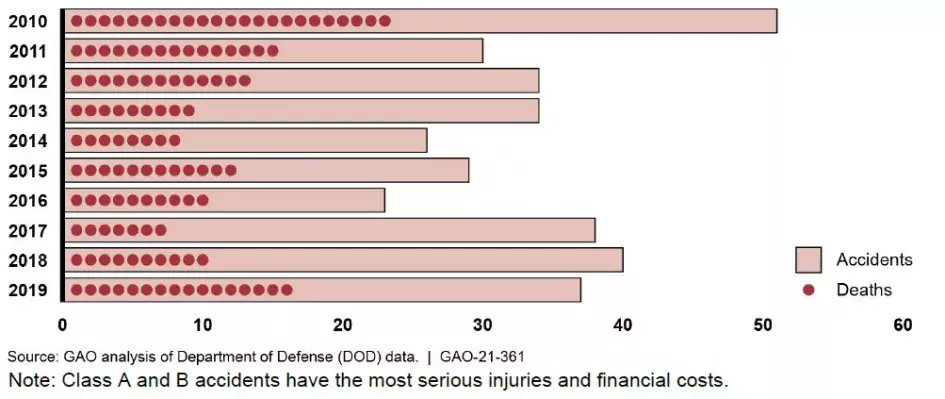Why Do So Many Military Vehicles Crash Outside of Combat, and What Is the Military Doing About It?
Army and Marine Corps personnel are trained to operate tactical vehicles, like tanks and trucks. However, the Army and Marine Corps reported 3,751 tactical vehicle accidents outside of combat that resulted in 123 servicemember deaths between FY 2010 and 2019.
Today’s WatchBlog post looks at our new report on tactical vehicle accidents, and how they can be prevented.
Image

How often did serious accidents occur?
On average, 34 Class A and B accidents (the most serious classes) took place each fiscal year from 2010 to 2019. Each of these accidents resulted in at least one death, permanent disability, multiple hospitalizations, or more than $500,000 in damages.
Number of Army and Marine Corps Class A and B Tactical Vehicle Accidents and Resulting Military Deaths, Fiscal Years 2010 through 2019
Image

What causes tactical vehicle accidents?
We found that human factors such as driver inattentiveness, lapses in supervision, and lack of training were the most common reported causes of vehicle accidents outside of combat. The Army and Marine Corps have practices to prevent or lessen the seriousness of vehicle accidents, but these practices are not always followed, often due to a focus on “getting the mission done.”
For example, personnel described risk assessments—used to identify hazards associated with tactical vehicle operations—that were inaccurate and reused without being updated, which artificially lowered perceived risk levels. Also, soldiers and marines we spoke with said they did not always take precautions that could reduce the severity of the accidents, such as using seatbelts or other restraints in tactical vehicles. Further, in some cases, we found that the restraints did not work or had been removed from the vehicle.
According to drivers and other personnel we talked with, the first-line supervisors, such as vehicle commanders, are responsible for enforcing safety practices such as speed limits and seatbelt use as well as coaching less-experienced drivers. Personnel told us that underqualified or inexperienced first-line supervisors can increase safety risks.
We found that insufficient tactical vehicle training can also contribute to accidents. In interviews with personnel across 9 Army brigades and 11 Marine Corps battalions, we found that driver training experience differed widely. Master drivers—who are responsible for licensing and training drivers in Army units—told us that competing priorities limited the amount of time available for training. For example, several master drivers said that it would typically take 1 week to complete night training properly, but that they conducted their training in 4 hours.
What can be done?
We made 9 recommendations that could allow the Army and Marine Corps to more safely operate tactical vehicles and ultimately save lives:
- Clearly define roles for first-line supervisors in tactical vehicles and establish processes to help them perform their role
- Assess the number of personnel within operational units who are responsible for tactical vehicle safety and determine if this level of staffing is appropriate
- Develop specific performance criteria and measurable standards for tactical vehicle driver training
- Comments on GAO’s WatchBlog? Contact blog@gao.gov.
GAO Contacts
Related Products

GAO's mission is to provide Congress with fact-based, nonpartisan information that can help improve federal government performance and ensure accountability for the benefit of the American people. GAO launched its WatchBlog in January, 2014, as part of its continuing effort to reach its audiences—Congress and the American people—where they are currently looking for information.
The blog format allows GAO to provide a little more context about its work than it can offer on its other social media platforms. Posts will tie GAO work to current events and the news; show how GAO’s work is affecting agencies or legislation; highlight reports, testimonies, and issue areas where GAO does work; and provide information about GAO itself, among other things.
Please send any feedback on GAO's WatchBlog to blog@gao.gov.


